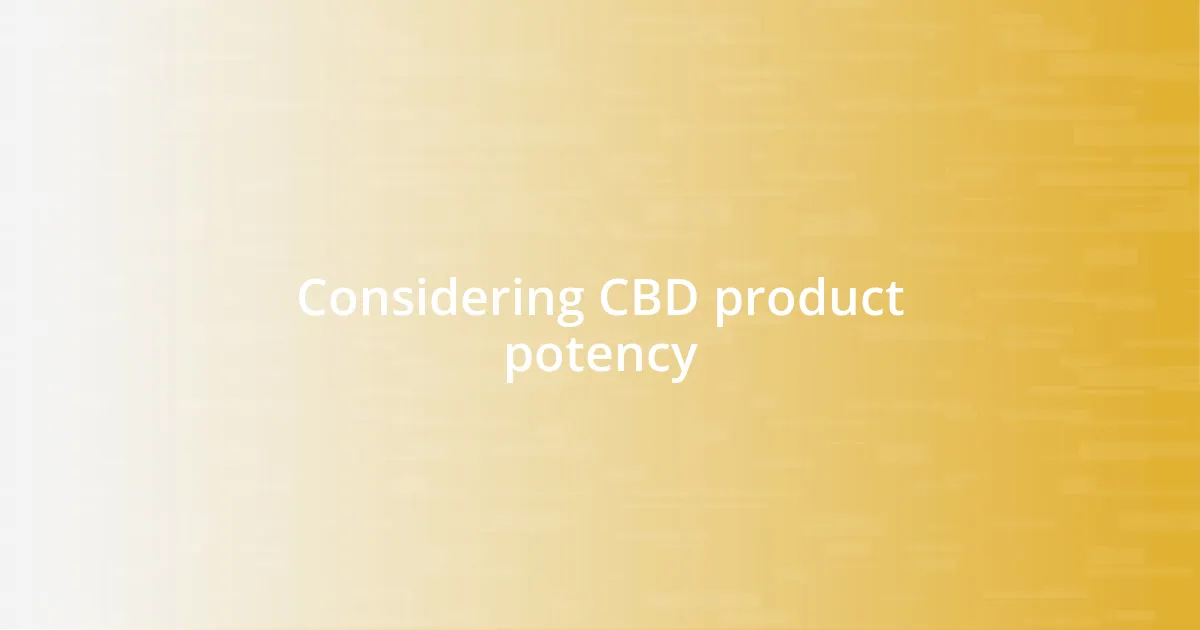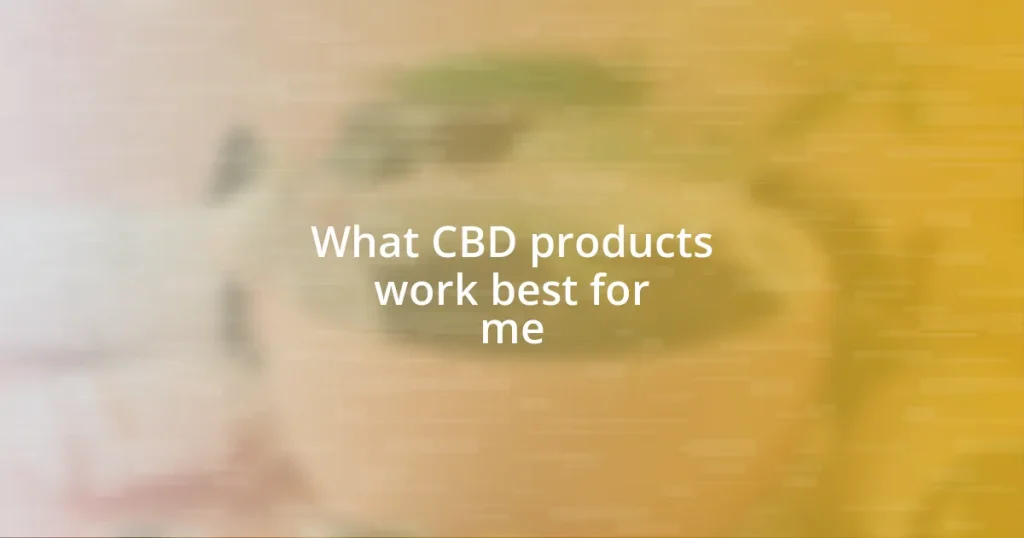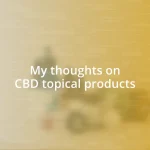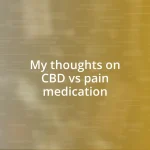Key takeaways:
- Understanding different CBD product types (tinctures, edibles, topicals) is essential for personalizing experiences and achieving desired effects.
- Evaluating personal needs and preferences helps narrow down choices, determining motivations and preferred consumption methods.
- Product potency varies significantly; starting low and adjusting based on individual response is crucial for effective use.
- Prioritizing third-party lab testing and reputable brands ensures product quality, safety, and effective decision-making.

Understanding CBD product types
When it comes to CBD products, the variety can be overwhelming. I remember the first time I walked into a store full of endless options—tinctures, edibles, topicals—the list seemed to go on forever. It felt like being a kid in a candy store, but instead of sweets, I was faced with choices that could impact my well-being.
Tinctures are often my go-to because they offer quick absorption and the ability to control dosage. I can easily adjust how much I take based on how I’m feeling that day. Have you ever tried a tincture? The dropper allows for precision, which is comforting, especially when you’re still figuring out what works best for you.
Edibles, on the other hand, provide a different kind of experience. I recall trying a CBD gummy for the first time and, honestly, I felt a bit like a kid again—a delicious treat that also brought a sense of calm. But here’s a question to ponder: how do you prefer to feel your CBD? The onset is much slower with edibles, which means you need to plan ahead, but they can also be a fun and tasty way to enjoy the benefits throughout the day.

Evaluating your personal needs
Evaluating your personal needs begins with reflecting on what you want to achieve with CBD. For me, the journey started when I realized I was looking for relief from stress and sleepless nights. It’s crucial to ask yourself some key questions: Are you hoping to manage anxiety, alleviate chronic pain, or simply enhance your well-being? This clarity can significantly narrow down your choices.
- Identify your primary motivations (anxiety relief, pain management, etc.)
- Consider your lifestyle (on-the-go convenience vs. at-home rituals)
- Think about your preferred consumption methods (quick-dosing vs. longer-lasting effects)
- Assess any potential interactions with medications or health conditions
As I navigated this process, I found it helpful to keep a journal. I’d jot down what I tried, how it made me feel, and what I was hoping to achieve. Over time, I began to see patterns that guided my decisions. Trust me, a little self-introspection can go a long way, making your CBD journey more personal and effective.

Considering CBD product potency
When considering CBD product potency, it’s essential to understand that not all products are created equal. I vividly remember when I first experimented with CBD, and I picked up a bottle labeled “300 mg.” It sounded good in theory, but the results left me wondering if it was enough. Potency, measured in milligrams, indicates how much CBD is in a product. Higher potency can mean stronger effects, but it’s crucial to start low and gradually increase based on your body’s response.
I often tell friends that it’s like finding your sweet spot with coffee—some may thrive on a single shot of espresso while others need a couple of cups to feel that buzz. That’s the beauty of CBD; its effects can vary significantly from person to person. You’ll need to pay attention to how your body reacts to different potencies. I remember a time when I tried a higher dose on a particularly stressful day, and while it helped ease my nerves, I realized I could have achieved similar results with a smaller amount.
It’s also important to distinguish between full-spectrum, broad-spectrum, and isolate products when assessing potency. I’ve tried all three, and they each have distinct benefits. Full-spectrum products contain a range of cannabinoids, which can enhance the overall effect due to something called the entourage effect. This term refers to how different compounds work together synergistically, providing benefits beyond what CBD alone can offer. However, if you’re sensitive to THC, broad-spectrum or isolate options might suit you better.
| Product Type | Potency (mg) |
|---|---|
| Full-Spectrum | Varies greatly, typically 300-1000 mg |
| Broad-Spectrum | Varies, often 300-750 mg |
| Isolate | Usually 99% pure CBD, can be up to 1000 mg |

Exploring different consumption methods
When it comes to exploring different consumption methods for CBD, the options can feel overwhelming. I remember my first attempt, trying a CBD oil tincture. The ease of placing a few drops under my tongue was appealing, but I quickly learned that the taste wasn’t quite what I expected. If you’re like me and prefer discretion, you might lean towards capsules or softgels. They’re easy to take and eliminate the aftertaste, perfect for those moments when I’m out and about.
Vaping is another method I’ve experimented with, and it’s fascinating how quickly the effects can kick in. I found myself appreciating the instant relief on days when anxiety crept in unexpectedly. But, I do wonder—what are the long-term effects of vaping? While I enjoyed the convenience, I decided to balance it out with other methods, like edibles, which provide a longer-lasting effect. It’s like a slow and steady approach to relief, and there’s something comforting about having a tasty gummy or chocolate on hand.
Then there’s topical application, which I discovered while seeking relief for sore muscles. Applying a CBD cream directly onto the area made me feel like I was pampering myself and addressing my needs simultaneously. But this method had me pondering: how is it that I feel immediate relief on my aching back but might not experience the same for anxiety? It’s this variety of methods that allows us to tailor our CBD experience to fit our lifestyles and personal preferences. How have you found your preferred method?

Assessing legal and quality factors
When diving into the legal landscape of CBD products, it’s essential to stay informed about state and federal regulations. I remember the confusion I felt while researching CBD laws; it varied wildly from one state to another. For instance, while CBD derived from hemp is federally legal in the U.S., states like Idaho and South Dakota have stricter rules, making local knowledge invaluable. Understanding the legal framework helps protect you from purchasing products that might be deemed illegal in your area, ensuring a smoother experience.
Quality assurance is another critical factor to consider. I can’t stress enough the importance of third-party lab testing. The first time I bought CBD gummies, I was thrilled about trying them, yet I later discovered they hadn’t undergone any testing. It left me uneasy about what exactly I was consuming. Products backed by credible lab results not only confirm the potency but also check for harmful contaminants. Always look for a Certificate of Analysis (COA); it’s like a report card for your CBD product, telling you exactly what you’re getting in terms of purity and concentration.
Additionally, choosing reputable brands can significantly affect your experience. I still think back to the moment I shifted from a mystery brand to a well-known CBD company. The difference was staggering—the quality was evident in the effects. Companies that prioritize transparency often provide detailed information about their sourcing and manufacturing processes. This transparency serves as a reassurance that I’m choosing a product that meets high standards. After all, don’t you want to feel confident that what you’re putting into your body is safe and effective?

Making informed purchasing decisions
Making informed purchasing decisions in the world of CBD can feel like navigating a maze. I vividly recall the excitement of discovering a new CBD brand, only to feel a pang of doubt when I couldn’t find any information about their sourcing practices. That experience taught me to prioritize transparency over temptation. Have you ever made a purchase only to regret it later? It’s frustrating, isn’t it?
To avoid that pitfall, I always check for third-party lab testing before I buy. When I finally learned about Certificates of Analysis, it was like a light bulb went off. Knowing that I was consuming a product that had been rigorously tested for potency and purity was incredibly reassuring. It feels good to be in control of what goes into my body. What can be more comforting than that?
Lastly, it’s vital to trust the brands you choose. I’ve found that sticking to reputable companies not only improves the quality of what I consume but also enhances my overall experience. The excitement of trying a new product becomes more enjoyable when I know I’m supporting a brand that values safety and quality. So next time you’re ready to buy, ask yourself: does this brand earn my trust? Trust plays a crucial role, and embarking on this journey with confidence makes all the difference.















